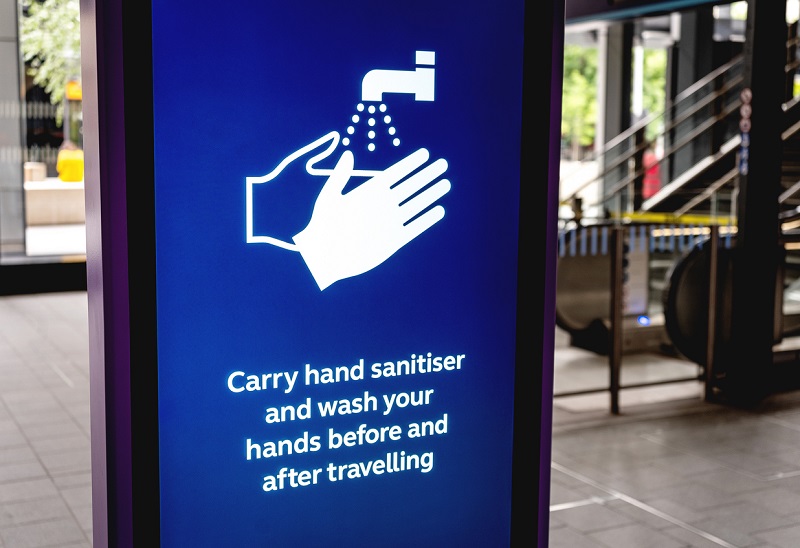Digital signage that includes an interactive display is a popular way for businesses to encourage customers’ engagement with their brand, company or product offerings. However, interactive signage has grown past simple touch over the past few years.
What is Interactive Signage?
Interactive signage is a type of large-scale digital display that is most often outfitted with a touchscreen. While some older versions of interactive signage utilize external keyboards or even computer mice to allow for interactivity, almost all modern systems include a touchscreen. More often than not, these displays are highly sensitive to touch, much like a smartphone would be.
 Interactive signage can be amazingly versatile, offering multiple points of interaction, making it a great fit for many environments from shopping malls to office building lobbies.
Interactive signage can be amazingly versatile, offering multiple points of interaction, making it a great fit for many environments from shopping malls to office building lobbies.
Why is Digital Signage Important for Businesses?
Interactive digital signage is designed to be both engaging and attractive. Because of this, it gives companies an incredible opportunity to talk directly to their customers when deployed properly. At the same time, it can offer a range of business insights while capturing customers’ interest and enhancing their overall experience.
Customer Benefits of Interactive Signage
Interactive signage can offer a wide range of benefits to customers and other users, including:
- Speed: The newest interactive signs are as fast as modern smartphones
- Ease of use: Most users own smart mobile devices, and are comfortable with touchscreen technology, making interactive signage easy for them to engage with.
- Accessibility: For customers with disabilities, interactive signage can create more equitable environments via accessibility features, like screen readers and large font options.
- Efficiency: Users are more able to “serve themselves” when interactive signage is available, and have less need to wait on assistance from an employee.
- Entertainment: Engaging content can help keep customers in-store for longer periods of time.
- Education: Digital signage is a great communication tool that can be used to educate users on everything from new products to their immediate environment, leading to a more positive customer experience.
Business Benefits of Interactive Signage
While there are many benefits to customers and other end-users, it’s safe to say that there are equally as many benefits to the companies that deploy them, including:

- Increased engagement/attention: Interactive signage can offer more opportunities to entertain and educate customers, as well as extend the amount of time they are in-store. It also makes for a memorable customer experience.
- Cost savings: While customer service attendants are a wonderful resource for complex issues, for simpler things, interactive signage may be just as effective, as well as being less expensive.
- Additional revenue: Digital signage can be used to display paid advertisements from other, related companies that don’t compete directly with the business itself.
- Flexibility: Available in a range of sizes and configurations, these signs can find a home in almost any environment
- Easily updated: Remote updating of content and software updates make interactive displays an excellent conduit for fresh, relevant information.
- Better customer experience: Customers are comfortable with touchscreen technology. At the same time, offering interactive signage gives businesses an opportunity to burnish their company or brand as a modern player in their space.
- Data collection: Digital signage can include software that tracks metrics like usage, as well as collecting customer feedback.
Types of Interactions Possible with Digital Signage
The original and still most common type of interactive signage is that configured with a highly-sensitive touchscreen. Touchscreens allow users to browse or search the display’s integrated database for information. These digital signs are very popular in office buildings when used as directories or for wayfinding. Similar use cases are common shopping malls, too.
QR Codes
QR codes let customers or visitors use their phones to scan information directly to their mobile devices. These codes can prompt everything from review collection to app downloads. They are especially useful for the mobile hand-off of wayfinding and directional information to users’ phones, and are commonly used in smart city kiosks.
Speech Detection and Recognition
Some interactive signage is equipped with passive microphones, much like an Amazon Alexa or Google Home device. This allows the signs to activate the listening functionality with certain keywords or phrases are used, making them usable even without the need to touch or otherwise physically manipulate the displays or integrated components. Speech detection can be an extremely useful feature in terms of accessibility, especially for those who may speak but not be able to write in the primary language used by the display, or for those who are blind or have limited sight. These displays make very helpful additions to government buildings, like courthouses, or college campuses.
Motion Tracking
This is probably the coolest looking but least common type of feature available for interactive signage. Essentially, the sign is enabled with components and software that allow the user’s gestures to be followed or “tracked,” thereby triggering various functionality. While not found in many places just yet (the technology is still very much a work in progress in most places), it could eventually be an interesting addition to signage that features games or other types of entertainment apps, like those in shopping centers or in retail stores.
Facial Detection & Recognition
Facial detection has many different uses, and is mostly used to secure accounts and limit access to them to only those who are approved to use them. Apple’s Face ID is a form of facial recognition that is used to secure their proprietary mobile devices, like iPhones and iPads. This technology also has other interesting applications. For instance, fast food restaurants are beginning to test facial recognition in their loyalty programs to quickly allow users to place orders at self-payment kiosks, when they are ordering a meal that has been categorized as a “favorite,” and instantly collecting payment via a pre-connected account.
RFID and NFC
While most people associate RFID and NFC technology solely with the ability to process payments, both are capable of much more than that. At their core, both RFID and NFC tech are simply ways of delivering information or triggering an action. So while they are probably most commonly used for payment applications, they can also be used to transmit informational downloads, like museum maps, deliver product guides and instructions in retail environments, or connect wireless devices to one another within a household.
Beacons
Beacons are poised to be the next big thing in location-based marketing. While they are quite a basic technology – just a simple, wireless transmitter – it’s less the hardware itself that is making waves, and more its various uses. Beacons help businesses optimize their advertising outreach by allowing them to gather better data and offer more useful promotions via proximity marketing. Users’ mobile phones pick up the beacons’ signals, letting advertisers know where their customers are at a given point in time. Examples of successful beacon use are not uncommon, but are especially prevalent in retail environments, where companies use it to target their ads to customers who they know are visiting or have visited their locations, and better tailor their offers to them.
Mobile Phone Interactivity
Mobile phones are used in most of these examples for one reason or another, but they can also be the place where the interactivity actually occurs. For instance, some companies have used mobile-first websites to host interactive games. These can be played directly on the device, and offer the ability for huge numbers of people to play the games together, creating a sense of community and connection between brand loyalists and the brand itself.
Augmented Reality
Those who use Google search may have recently encountered a new feature that allows users to get up close and personal with…wild animals. No, this isn’t a joke, but it is a neat example of a company using AR to engage with its customers. If a user happens to search for one of a specific selection of animals in its database (and even some fantasy creatures, like unicorns!), Google then asks the user if they’d like to see it in their current environment. They can then choose to view the animal wherever they’re at, via their mobile device, but in their personal surroundings, whether in their living room or in the middle of Times Square.
How to Deploy an Interactive Digital Signage Program
Developing and deploying an interactive digital signage kiosk or program might seem like a huge project, but there are ways to make the process simpler.
- Understand the KPIs: Important to know exactly what needs are to be met with the sign. For example, will it simply display information, or is it intended to to increase revenue?
- Find an experienced kiosk manufacturing partner: There are many companies that build kiosks, but not all of them are able to provide every service or type of kiosk required by a given project. Ensure that the manufacturer selected has experience building and deploying the type of kiosk needed for the project.
- Design the Sign: Turn-key interactive signage manufacturers like REDYREF are able to provide assistance from kiosk design and manufacturing, all the way through its deployment and servicing.
- Deploy Kiosks: Most companies prefer to utilize manufacturers that are capable of not just shipping and delivery, but also set up and training.
- Measure Results: Digital signage can be equipped with software that allows for remote reporting of key metrics, in particular, the KPIs identified at the project’s inception.
Why Choose REDYREF for Interactive Signage
With more than 100 years of experience as a leading American kiosk manufacturer, REDYREF knows how to build interactive digital signage for any environment. From touchscreen information signage and payment kiosks to wayfinding and ticketing, REDYREF is able to create the best and most efficient kiosk solutions on the market. Curious to learn more? Request a quote online, or call 1.800.628.3603 for additional information.


